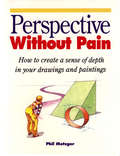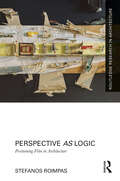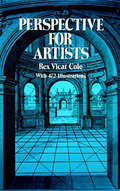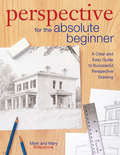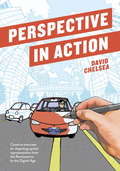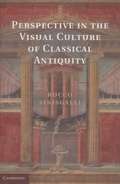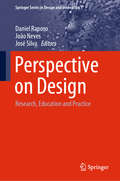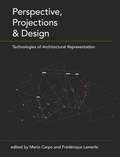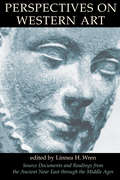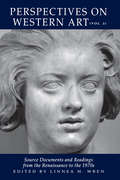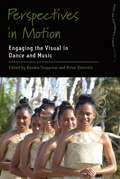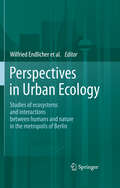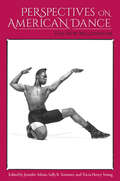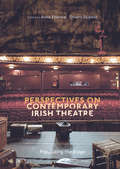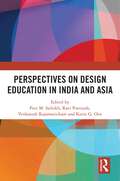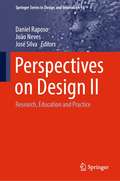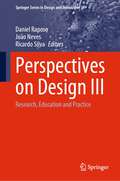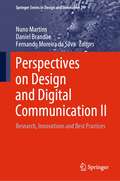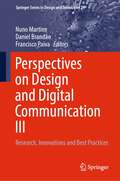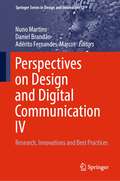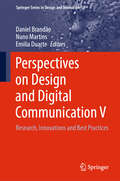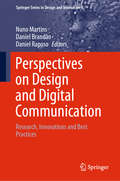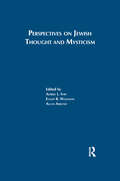- Table View
- List View
Perspective Without Pain: The Basics (Specials Ser.)
by Phil MetzgerImagine perspective without pain-no T-squares, complicated equations or mechanical terms-just simple instructions and hands-on exercises to teach you how to create a sense of depth in your drawings and paintings. Now go a step further-imagine having fun with perspective. With this book, you will. Here Phil Metzger give you clear-cut guidelines in everyday terms-with a lot of friendliness and a little humor tossed in along the way. As an experienced artist, he understands how you work, and he knows that the last thing you need is a lot of rigid rules to tie you down. Here you'll learn techniques of perspective that will help your creativity-not hinder it. You'll learn how to: Achieve the illusion of depth by gradually diminishing the sizes of-and the distance between-similar objects Use soft edged and less detail on objects in the background to make them seem farther away Introduce depth simply by manipulating color and value Draw from any viewpoint-on either side, above or below Draw accurate angles without complicated measuring devices Use perspective to track down the problem when something you've drawn just doesn't look right Measures relative sizes and add the details that make the difference between a convincing pictures and an awkward one Properly draw roads, paths, streets, fields and streams to suggest depth in a scene and to describe the flatness or hilliness of a landscape.
Perspective as Logic: Positioning Film in Architecture (Routledge Research in Architecture)
by Stefanos RoimpasPerspective as Logic offers an architectural examination of the filmic screen as an ontologically unique element in the discipline’s repertoire. The book determines the screen’s conditions of possibility by critically asking not what a screen means, but how it can mean anything of architectural significance. Based on this shift of enquiry towards the question of meaning, it introduces Jacques Lacan and Alain Badiou in an unprecedented way to architecture—since they exemplify an analogous shift of perspective towards the question of the subject and the question of being accordingly. The book begins by positing perspective projection as being a logical mapping of space instead of a matter of sight (Alberti & Lacan). Secondly, it discusses the very nature of architecture’s view and relation to the topological notion of outside between immediacy and mediation (Diller and Scofidio, The Slow House). It examines the limitation of pictorial illusion and the productive negativity in the suspension of architecture’s signified equivalent to language’s production of undecidable propositions (Eisenman & Badiou). In addition, the book outlines the difference between the point of view and the vanishing point by introducing two different conceptions of infinity (Michael Webb, Temple Island). Finally, a series of design experiments playfully shows how the screen exemplifies architecture’s self-reflexive capacity where material and immaterial components are part of the spatial conception to which they refer and produce. This book will be particularly appealing to scholars of architectural theory, especially those interested in the domains of philosophy, psychoanalysis and the linguistic turn of architecture.
Perspective as Symbolic Form: An Essay On Infinite Naming (Zone Bks.)
by Erwin PanofskyErwin Panofsky’s Perspective as Symbolic Form is one of the great works of modern intellectual history, the legendary text that has dominated all art-historical and philosophical discussions on the topic of perspective in this century. Finally available in English, this unrivaled example of Panofsky’s early method places him within broader developments in theories of knowledge and cultural change. Here, drawing on a massive body of learning that ranges over ancient philosophy, theology, science, and optics as well as the history of art, Panofsky produces a type of “archaeology” of Western representation that far surpasses the usual scope of art historical studies. <P><P>Perspective in Panofsky’s hands becomes a central component of a Western “will to form,” the expression of a schema linking the social, cognitive, psychological, and especially technical practices of a given culture into harmonious and integrated wholes. He demonstrates how the perceptual schema of each historical culture or epoch is unique and how each gives rise to a different but equally full vision of the world.Panofsky articulates these distinct spatial systems, explicating their particular coherence and compatibility with the modes of knowledge, belief, and exchange that characterized the cultures in which they arose. Our own modernity, Panofsky shows, is inseparable from its peculiarly mathematical expression of the concept of the infinite, within a space that is both continuous and homogenous.
Perspective for Artists (Dover Art Instruction Ser.)
by Rex Vicat ColeRex Vicat Cole makes learning about perspective an enjoyable and fascinating pursuit in this clearly written and profusely illustrated book. Over 390 diagrams illustrate every aspect of the text, and more than 80 illustrations reproduce drawings and paintings — by old masters and by the author — that indicate how perspective is utilized in practice. The book is so well illustrated that many perspective problems can be answered without reference to the text at all. The text itself clarifies the theory of perspective and offers numerous practice exercises. Among the topics covered are the principle of perspective in theory, the rules of perspective and their application, depths, the use of plans in sketching foreshortened surfaces, inclined planes, the circle, arches, how to draw curves by straight lines, perspective of the sky and sea, perspective of shadows, and more. Two additional sections cover perspective in the history of art and mechanical perspective.A noted landscape painter and art instructor, Mr. Cole combines common sense with an understanding of Nature's laws to make perspective a subject that every artist can approach with confidence. Art students will also find this book extremely valuable.
Perspective for the Absolute Beginner: A Clear and Easy Guide to Successful Perspective Drawing
by Mary Willenbrink Mark WillenbrinkPerspective made simple. How to draw in a realistic style. Perspective is arguably the most important element of drawing and also one of the most difficult to master. It's what gives drawings dimension and is the key to realistic drawing. Now the best-selling authors of Drawing for the Absolute Beginner are here to demystify perspective, simplify concepts such as vanishing points and multi-point perspective, and make it easy for you to experience success...and have fun while you're doing it.Tricks and techniques for creating depth and dimension using lines (linear perspective), values (atmospheric perspective) and color.23 mini demonstrations on how to apply basic principles of perspective make getting started easy.12 full step-by-step demonstrations, each with a structural drawing, cover a variety of subjects, including interiors, architecture and still lifes.Starting with a simple box to illustrate fundamental concepts, artists will develop a working understanding of how to cast any subject in realistic depth and dimension. This book puts it all into perspective.
Perspective in Action: Creative Exercises for Depicting Spatial Representation from the Renaissance to the Digital Age
by David ChelseaUsing a fun and accessible graphic novel format, Perspective in Action features 33 easy-to-follow demonstrations to teach artists the major discoveries in perspective. Perspective is a fundamental element in the development of art and for understanding spatial relationships, but it is an underserved topic in the world of art instruction. Author and artist David Chelsea takes readers through the major perspective-related developments in history, teaching them how to re-create these same experiments by leading artists in all fields (including drawing, painting, and sculpture). Covering a wide-range of mediums (pen and ink, paint, chalk, digital art, woodwork, and more), Perspective in Action gives readers a more hands-on approach to perspective, as opposed to the usual theoretical presentations found in other books.
Perspective in the Visual Culture of Classical Antiquity
by Rocco SinisgalliLinear perspective is a science that represents objects in space upon a plane, projecting them from a point of view. This concept was known in classical antiquity. In this book, Rocco Sinisgalli investigates theories of linear perspective in the classical era. Departing from the received understanding of perspective in the ancient world, he argues that ancient theories of perspective were primarily based on the study of objects in mirrors, rather than the study of optics and the workings of the human eye. In support of this argument, Sinisgalli analyzes, and offers new insights into, some of the key classical texts on this topic, including Euclid's De speculis, Lucretius' De rerum natura, Vitruvius' De architectura, and Ptolemy's De opticis. Key concepts throughout the book are clarified and enhanced by detailed illustrations.
Perspective on Design: Research, Education and Practice (Springer Series in Design and Innovation #1)
by José Silva Daniel Raposo João NevesThis book presents the outcomes of recent endeavors that are expected to foster significant advances in the areas of communication design, fashion design, interior design, and product design, as well as overlapping areas. The fourteen chapters highlight carefully selected contributions presented during the 6th EIMAD conference, held on February 22–23, 2018 at the School of Applied Arts, Campus da Talagueira, in Castelo Branco, Portugal. They report on outstanding advances that offer new theoretical perspectives and practical research directions in design, and which are aimed at fostering communication in a global, digital world, while also addressing key individual and societal needs.
Perspective, Projections and Design: Technologies of Architectural Representation
by Mario Carpo Frédérique LemerleThe essays selected for this book, presented in chronological order, discuss various aspects of image-making technologies, geometrical knowledge and tools for architectural design, focusing in particular on two historical periods marked by comparable patterns of technological and cultural change. The first is the Renaissance; characterized by the rediscovery of linear perspectives and the simultaneous rise of new formats for architectural drawing and design on paper; the second, the contemporary rise of digital technologies and the simultaneous rise of virtual reality and computer-based design and manufacturing. Many of the contributing authors explore the parallel between the invention of the perspectival paradigm in early-modern Europe and the recent development of digitized virtual reality. This issue in turn bears on the specific purposes of architectural design, where various representational tools and devices are used to visualize bi-dimensional aspects of objects that must be measured and eventually built in three-dimensional space.
Perspectives On Western Art, Vol.1: Source Documents And Readings From The Ancient Near East Through The Middle Ages
by Linnea WrenThis anthology of readings related to Western art history explains specific works of art illustrated in Janson's History of Art and De la Croix and Tansey's Gardner's Art Through the Ages in terms of the ideas, beliefs, and concerns of the people and cultures who created the art. It brings a new understanding of art because it shows the social and cultural basis of major works of art through history. The ten sections are Ancient Near East; Egyptian; Aegean; Greek; Etruscan; Roman; early Christian, Byzantine, and Islamic; early Medieval; Romanesque; and Gothic. The readings have been drawn from many areas of intellectual and social history, including religion, philosophy, literature, science, economics, and law. Each selection is preceded by an introductory note, which discusses the readings in terms of its subject and theme, its source and usage, and its relevance to the study of the work of art.
Perspectives On Western Art: Source Documents And Readings From The Renaissance To The 1970s
by Linnea WrenThis anthology of readings related to Western art history explains specific works of art illustrated in Janson's History of Art and De la Croix and Tansey's Gardner's Art Through the Ages in terms of the ideas, beliefs, and concerns of the people and cultures who created the art. It brings a new understanding of art because it shows the social and cultural basis of major works of art through history. The ten sections are Ancient Near East; Egyptian; Aegean; Greek; Etruscan; Roman; early Christian, Byzantine, and Islamic; early Medieval; Romanesque; and Gothic. The readings have been drawn from many areas of intellectual and social history, including religion, philosophy, literature, science, economics, and law. Each selection is preceded by an introductory note, which discusses the readings in terms of its subject and theme, its source and usage, and its relevance to the study of the work of art.
Perspectives in Motion: Engaging the Visual in Dance and Music (Dance and Performance Studies #15)
by Kendra Stepputat Brian DiettrichFocusing on visual approaches to performance in global cultural contexts, Perspectives in Motion explores the work of Adrienne L. Kaeppler, a pioneering researcher who has made a number of interdisciplinary contributions over five decades to dance and performance studies. Through a diverse range of case studies from Oceania, Asia, and Europe, and interdisciplinary approaches, this edited collection offers new critical and ethnographic frameworks for understanding and experiencing practices of music and dance across the globe.
Perspectives in Motion: Engaging the Visual in Dance and Music (Dance and Performance Studies #15)
by Kendra Stepputat Brian DiettrichFocusing on visual approaches to performance in global cultural contexts, Perspectives in Motion explores the work of Adrienne L. Kaeppler, a pioneering researcher who has made a number of interdisciplinary contributions over five decades to dance and performance studies. Through a diverse range of case studies from Oceania, Asia, and Europe, and interdisciplinary approaches, this edited collection offers new critical and ethnographic frameworks for understanding and experiencing practices of music and dance across the globe.
Perspectives in Urban Ecology
by Wilfried EndlicherThis book gives an interdisciplinary overview on urban ecology. Basic understanding of urban nature development and its social reception are discussed for the European Metropolitan Area of Berlin. Furthermore, we investigate specific consequences for the environment, nature and the quality of life for city dwellers due to profound changes such as climate change and the demographic and economic developments associated with the phenomena of shrinking cities. Actual problems of urban ecology should be discussed not only in terms of natural dimensions such as atmosphere, biosphere, pedosphere and hydrosphere but also in terms of social and cultural dimensions such as urban planning, residence and recreation, traffic and mobility and economic values. Our research findings focus on streets, new urban landscapes, intermediate use of brown fields and the relationships between urban nature and the well-being of city dwellers. Finally, the book provides a contribution to the international discussion on urban ecology.
Perspectives on American Dance: The New Millennium
by Jennifer Atkins, Sally R. Sommer, and Tricia Henry YoungDancing embodies cultural history and beliefs, and each dance carries with it features of the place where it originated. Influenced by different social, political, and environmental circumstances, dances change and adapt. American dance evolved in large part through combinations of multiple styles and forms that arrived with each new group of immigrants. Perspectives on American Dance is the first anthology in over twenty-five years to focus exclusively on American dance practices across a wide span of American culture. This volume and its companion show how social experience, courtship, sexualities, and other aspects of life in America are translated through dancing into spatial patterns, gestures, and partner relationships. This volume of Perspectives on American Dance features essays by a young generation of authors who write with familiarity about their own era, exploring new parameters of identity and evaluating a wide variety of movement practices being performed in spaces beyond traditional proscenium stages. Topics include "dorky dancing" on YouTube; same-sex competitors on the TV show So You Think You Can Dance; racial politics in NFL touchdown dances; the commercialization of flash mobs; the connections between striptease and corporate branding; how 9/11 affected dance; the criminalization of New York City club dancing; and the joyous ironies of hipster dance. This volume emphasizes how dancing is becoming more social and interactive as technology opens up new ways to create and distribute dance. The accessible essays use a combination of movement analysis, thematic interpretation, and historical context to convey the vitality and variety of American dance. They offer new insights on American dance practices while simultaneously illustrating how dancing functions as an essential template for American culture and identity. Contributors: Jennifer Atkins | Jessica Berson | J. Ellen Gainor | Patsy Gay | Ansley Jones | Kate Mattingly | Hannah Schwadron | Sally Sommer, Ph.D. | Ina Sotirova | Dawn Springer | Michelle T. Summers | Latika L. Young | Tricia Henry Young
Perspectives on Contemporary Irish Theatre
by Anne Etienne Thierry DubostThis book addresses the notion posed by Thomas Kilroy in his definition of a playwright's creative process: 'We write plays, I feel, in order to populate the stage'. It gathers eclectic reflections on contemporary Irish theatre from both Irish theatre practitioners and international academics. The eighteen contributions offer innovative perspectives on Irish theatre since the early 1990s up to the present, testifying to the development of themes explored by emerging and established playwrights as well as to the (r)evolutions in practices and approaches to the stage that have taken place in the last thirty years. This cross-disciplinary collection devotes as much attention to contextual questions and approaches to the stage in practice as it does to the play text in its traditional and revised forms. The essays and interviews encourage dialectic exchange between analytical studies on contemporary Irish theatre and contributions by theatre practitioners.
Perspectives on Design Education in India and Asia
by Venkatesh Rajamanickam Ravi Poovaiah Peer M. Sathikh Karin G. OenThis book spotlights design and media education in Asia, with contributors providing their reflections on curriculum development, pedagogy, and practice from Australia, China, Japan, India, Mongolia, the Philippines, Singapore, and Turkey.The chapters provide in-depth and specific examples of how curricula and educational resources have been organised with respect to a wide variety of subjects, including aesthetics, engineering, and practice-based coursework. These course plans have also been adapted to respond to questions about integrating emerging technologies in the classroom and addressing changing industry needs as well as the need to encourage resilience and leadership skills across student and faculty cohorts. Although not an analysis of educational and industrial policies, some key documents such as The India Design Report of 1958 by Charles and Ray Eames and India’s National Education Policy of 2020 are referenced to provide important background information for understanding the past, present, and future of the design education ecosystem across the region.Presenting both historical context and practical contemporary applications of curricula in specific universities and design schools, this volume is compiled to share resources among faculty and researchers interested in global Asian design pedagogy who have previously relied upon publications centred on the UK and US contexts. It will appeal to design educators and anyone responsible for design education curricula across the Asian region and beyond.
Perspectives on Design II: Research, Education and Practice (Springer Series in Design and Innovation #16)
by José Silva Daniel Raposo João NevesThis book reports on interdisciplinary research and practices in communication, interior, fashion and product design, highlighting strategies for systematizing the design approach in a global, digital world. It gathers a selection of chapters written by the authors of the best articles presented at the 7th EIMAD conference, held online on May 14–15, 2020, from Portugal. The works were chosen for their particular link to contemporary concerns in terms of identity, health and well-being, social inclusion, sustainability, education and environment and, among others. They cover and bridges between important aspects of design education, research and practice, as well as creativity and emerging technology, offering a timely perspective and a source of inspiration to researchers, professionals and educators in design, product development and related fields.
Perspectives on Design III: Research, Education and Practice (Springer Series in Design and Innovation #34)
by Daniel Raposo João Neves Ricardo SilvaThis book reports on interdisciplinary research and practices in communication, fashion, product, and interior design, highlighting strategies for systematizing the design approach in a global and digital world. It gathers a selection of chapters written by the authors of the best articles presented at the 8th EIMAD conference, on July 07–08, 2022, Portugal. This chapters were chosen considering their particular link to contemporary concerns and challenges, considering the design contribution to health and well-being, social inclusion, sustainable development, design education, and environment and, among others. They cover and bridges between important aspects of design education, research, and practice, as well as creativity and emerging technology, offering a timely perspective and a source of inspiration to researchers, professionals and educators in design, product development and related fields.
Perspectives on Design and Digital Communication II: Research, Innovations and Best Practices (Springer Series in Design and Innovation #14)
by Fernando Moreira da Silva Nuno Martins Daniel BrandãoThis book gathers new empirical findings fostering advances in the areas of digital and communication design, web, multimedia and motion design, graphic design, branding, and related ones. It includes original contributions by authoritative authors based on the best papers presented at the 4th International Conference on Digital Design and Communication, Digicom 2020, together with some invited chapters written by leading international researchers. They report on innovative design strategies supporting communication in a global, digital world, and addressing, at the same time, key individual and societal needs. This book is intended to offer a timely snapshot of technologies, trends and challenges in the area of design, communication and branding, and a bridge connecting researchers and professionals of different disciplines, such as graphic design, digital communication, corporate, UI Design and UX design.
Perspectives on Design and Digital Communication III: Research, Innovations and Best Practices (Springer Series in Design and Innovation #24)
by Francisco Paiva Nuno Martins Daniel BrandãoThis book gathers new empirical findings fostering advances in the areas of digital and communication design, web, multimedia and motion design, graphic design, branding, and related ones. It includes original contributions by authoritative authors based on the best papers presented at the 5th International Conference on Digital Design and Communication, Digicom 2021, together with some invited chapters written by leading international researchers. They report on innovative design strategies supporting communication in a global, digital world, and addressing, at the same time, key individual and societal needs. This book is intended to offer a timely snapshot of technologies, trends and challenges in the area of design, communication and branding, and a bridge connecting researchers and professionals of different disciplines, such as graphic design, digital communication, corporate, UI Design and UX design.
Perspectives on Design and Digital Communication IV: Research, Innovations and Best Practices (Springer Series in Design and Innovation #33)
by Nuno Martins Daniel Brandão Adérito Fernandes-MarcosThis book gathers new empirical findings fostering advances in the areas of digital and communication design, web, multimedia and motion design, graphic design, branding, and related ones. It includes original contributions by authoritative authors based on the best papers presented at the 6th International Conference on Digital Design and Communication, Digicom 2022, together with some invited chapters written by leading international researchers. They report on innovative design strategies supporting communication in a global, digital world, and addressing, at the same time, key individual and societal needs. This book is intended to offer a timely snapshot of technologies, trends and challenges in the area of design, communication and branding, and a bridge connecting researchers and professionals of different disciplines, such as graphic design, digital communication, corporate, UI Design and UX design.
Perspectives on Design and Digital Communication V: Research, Innovations and Best Practices (Springer Series in Design and Innovation #50)
by Nuno Martins Daniel Brandão Emilia DuarteThis book gathers new empirical findings fostering advances in the areas of digital and communication design, web, multimedia and motion design, graphic design, branding, and related ones. It includes original contributions by authoritative authors based on the best papers presented at the 7th International Conference on Digital Design and Communication, Digicom 2023, together with some invited chapters written by leading international researchers. They report on innovative design strategies supporting communication in a global, digital world, and addressing, at the same time, key individual and societal needs. This book is intended to offer a timely snapshot of technologies, trends and challenges in the area of design, communication and branding, and a bridge connecting researchers and professionals of different disciplines, such as graphic design, digital communication, corporate, UI Design and UX design.
Perspectives on Design and Digital Communication: Research, Innovations and Best Practices (Springer Series in Design and Innovation #8)
by Daniel Raposo Nuno Martins Daniel BrandãoThis book shares new research findings and practical lessons learned that will foster advances in digital design, communication design, web, multimedia and motion design, graphic design and branding, and other related areas. It gathers the best papers presented at the 3rd International Conference on Digital Design and Communication, DIGICOM 2019, held on November 15–16, 2019, in Barcelos, Portugal. The respective contributions highlight new theoretical perspectives and practical research directions in design and communication, aimed at promoting their use in a global, digital world. The book offers a timely guide and a source of inspiration for designers of all kinds (Graphic, Digital, Web, UI & UX Design and Social Media), for researchers, advertisers, artists, entrepreneurs, and brand or corporate communication managers, and for teachers and advanced students.
Perspectives on Jewish Though
by IvryFirst Published in 1998. Routledge is an imprint of Taylor & Francis, an informa company.
